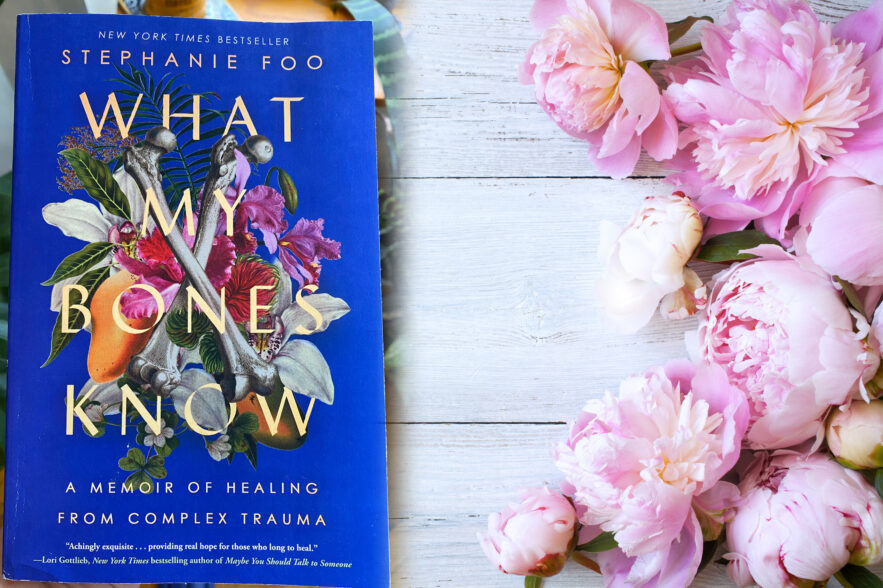Complex PTSD
“What My Bones Know” opens with a diagnosis, the author’s. Stephanie Foo, previously a producer at NPR’s “This American Life,” and by her own admission a successful journalist in a happy relationship, learns she has complex Post Traumatic Stress Disorder (PTSD) in an online therapy session in 2018 with her therapist of eight years, Samantha.
“Not just PTSD. Complex PTSD. The difference between regular PTSD and complex PTSD is that a traditional PTSD is often associated with a moment of trauma. Sufferers of complex PTSD have undergone continual abuse – trauma that has occurred over a long period of time, over the course of years. Child abuse is a common cause of complex PTSD,” she [Samantha] says [to Foo]. Then her eyes drift to the corner of the screen. “Oh – we’re out of time! Let’s continue next week.”

Foo refers to “What My Bones Know” as her origin story. Rather than outrun her past, she aims to face it and fix it. Her memoir is a dizzyingly difficult look at her life, from her childhood to her present (30 years old), and the process churns up everything she has long ago buried. In her reckoning is her redemption.
As Foo learns about C-PTSD, many readers will hear about it for the first time, and others will recognize their own journey in these pages. As a journalist, and also as someone who is writing about their own learning process, Foo does a spectacular job weaving the personal narrative with the what C-PTSD is, along with research on how to treat it. There is also a lot of trauma that she revists in these pages, much of it emotionally and physically violent. It is something readers should know ahead of time, so that they can care for their own triggers and mental health, and something Foo recognizes in the opening page.
Foo’s origin story begins before she was born. Her parents are ethnically Chinese living in Malaysia when Foo is born. The Chinese in Malaysia faced fierce discrimination. When he was younger, her father had studied abroad in California for college, and after her birth, he brought his family back to the land of frisbees and freedom. Ironically, his own daughter would go on to also struggle with the fierce discrimination in the US as an Asian/Asian-American. Her ethnicity, and being an immigrant, is something that Foo writes eloquently about later on when she researches C-PTSD.
Foo was 2-and-a-half-years-old when her family immigrated to Santa Cruz, California. Her dad had a tech job, they lived in a house with a pool, and they went to church on Sundays. In the chapters of her childhood, we see what happens behind closed doors, not just on the surface. For example, Foo describes a Girl Scout trip which seemingly went perfectly fine, only to face verbal and physical blows from her mother the moment they got home.
In order to survive, there is a lot about her childhood that Foo had to bury deep inside of her, away from her preferred memories. At the same time, there is also a lot of trauma that Foo would share freely with people, as if to explain away her own appalling behavior.
She did not bury everything. One thing she explains holding onto through adulthood is the memories of her whippings. These memories haunt the pages of her memoir; they are vivid, traumatic, unexpectedly funny at times, and unfortunately frequent. In multiple scenes, her parents threaten to kill each other, threaten to kill her, with Foo having to plead with them with the reasons she should live.
When Foo is in the middle of high school, her mom leaves, and then her father. In these pages are her survival. She lists three reasons she didn’t kill herself at the time: she was too “chickenshit,” she still had two remaining friends, and journalism. She was the editor-in-chief of her high school paper, and wrote a column for a local paper. In reporting on her school district’s funding scandal for her local paper, she was a dogged journalist who wrote headlining articles that not even the larger local papers would cover.
“This was how I discovered the power of journalism – not just as a force to right wrongs and change the world, but as a force that turned my anguished brain into a functioning machine.”
Foo goes on to say that achievement was her comfort, and this is how Foo becomes the adult version of herself today with an impressive resume. She graduated from UC Santa Cruz early (in a mere two and a half years!) with honors. She wrote for the college humor paper and already had freelanced for national magazines. It was time for her to start the next level of achievement. Meanwhile, in her personal life, she builds bridges only to burn them to the ground in spectacular fashion. In her early 20s she has the self-realization that maybe it wasn’t them, maybe it was her.
Foo’s memoir tells the story of her childhood trauma, of her seemingly scorched-and-burned personal life because of it, and of her professional achievements, which she used to overcome it. That is, until she began her quest to truly heal from C-PTSD.
While the memoir does follow a somewhat chronological order, it also must also tell these multiple stories at once. When Foo realizes that the problem might be her, not others, and that she has complex PTSD, she dives into it like any great journalist would. She researches the heck out of it, and then writes. She gives her personally traumatic, but professionally a dream job at NPR’s “This American Life,” notice, and quits in order to heal.
Now unemployed, Foo embarks on a deep dive on C-PTSD and how to fix it. The first thing she finds is that the condition doesn’t exactly exist. “Complex” PTSD was named by a psychiatrist in the 90s. However, it does not exist in the Diagnostic and Statistical Manual of Mental Disorders (DSM-5), which is the standard classification of mental disorders.
A push to add C-PTSD to the updated DSM-5 was rebuked because it was supposedly too similar to PTSD. Meanwhile, Foo notes, however, that both the U.S. Department of Veteran Affairs and the United Kingdom National Health Service recognize C-PTSD as a diagnosis.
But there is a difference between PTSD and C-PTSD. Foo illustrates the difference by using a made-up example of someone getting hit by a car on the way to Krispy Kreme as an example of a PTSD event. In order to heal, they could learn to isolate the trigger, use exposure therapy to walk by the Krispy Kreme daily, etc. On the other hand, C-PTSD does not have one foundational traumatic moment, but rather thousands.
“My freak-outs are more or less constant, a fixed state of being,” she says. She describes it as being exponentially more difficult to heal from. Things like disappointment, abandonment, love, could be triggers that are experienced hourly.
In her research, one study she comes across is the Kaiser Permanente (1995-1997) Adverse Childhood Experiences (ACE) study, whose questionnaire on childhood trauma was completed by over 17,000 patients. The study helped to form a score scale from 0 to 10, with the higher the score indicating a higher level of trauma. The results of the study showed that people with higher ACE scores were at greater risk for liver cancer and heart disease. And the highest risks: 7x more likely to become alcoholic, 4.5x more likely to suffer depression, and 12x more likely to attempt suicide.
Foo herself discovered this study in 2018. In 2020, a co-principal investigator of the study, Robert F. Anda, published an article and a YouTube video revealing the now-understood limitations of ACE scores. The scores changed the landscape epidemiologically, “for people to understand the overall significance of childhood trauma on public health,” as Foo summarizes.
But there are nuances that can mean your score is not a predetermined outcome set in stone. Variances, such as access to mental health resources, gender, etc. show that it is possible to change your likely outcome. Foo writes that she was relieved to learn more about this when Anda released his article later on, but at the time as she read the initial study in 2018, she “felt anxious and stigmatized as hell”. Even in her journey to learn more about C-PTSD in order to heal herself, she experiences more trauma.
Foo tries to find others who have C-PTSD. She researches Cognitive Behavioral Therapy (CBT) and its cellar-dwelling success rates in successfully treating C-PTSD. She reads books like Gretchen Schmelzer’s “Journey Through Trauma” and “The Body Keeps the Score” by Bessel van der Kolk.
Van der Kolk writes about a form of therapy called “Eye Movement Desensitization and Reprocessing (EMDR),” where patients recall traumas while moving their eyes left to right. Foo decides to try it. We follow along as she experiences it. We see her revisit some of her traumas, and then move from knowing to understanding, it wasn’t my fault. It is one of the many times I literally did an internal cheer while reading this book.
When Foo realizes that she is treating the symptoms, not the source, she goes back to her childhood. This last half of the memoir is the real heart of it all. It is painful to read at times, and to be honest I don’t even know how Foo got through some of it. But the story of her journey is gorgeous, heart-splitting, and absolutely healing.
That is not to say that Foo is healed, as in an “everything has gone away for good” kind of healed. Foo says near the end of her memoir that she is neither healed nor even in “remission.” But she has found love in herself and in her life. She has learned to manage her many triggers, and has found that slippery feeling that, from her own parents, eluded her all these years: a sense of family that coexists with love, which is finally found at the altar. But best of all, when it comes to her C-PTSD, she has found a way forward.
“What My Bones Know” is the brave and miraculous memoir of a woman who survived childhood trauma, learned she had complex PTSD, and figures out the ways in which she can heal from it. Readers will cringe with her, cheer with her, and in the end, celebrate with her. Healing from complex PTSD is a lifelong endeavor, and it is more than possible. It is necessary.






